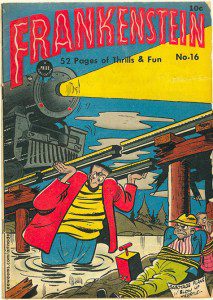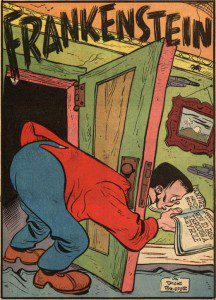 If you’re a regular reader of this column then you’re obviously a person of taste and intelligence. You might also have noticed by now that, although it’s ostensibly a column about Horror Comics, I tend to go off on tangents as often as an ADHD toddler in a ‘Shiny Things’ factory.
If you’re a regular reader of this column then you’re obviously a person of taste and intelligence. You might also have noticed by now that, although it’s ostensibly a column about Horror Comics, I tend to go off on tangents as often as an ADHD toddler in a ‘Shiny Things’ factory.
This month however I’m going to narrow the beady eye of the column not only to Horror Comics but to one individual horror comic creator. I know that many of you might have turned up simply for the knob gags and the celebrity fisting anecdotes, but sometimes this column has to do exactly what it says on the tin. Especially if the tin says ‘shut up and get to the fucking point’.
The genius of Dick Briefer
This month’s column is all about the comics genius of Dick Briefer.
Seconds after I typed that last sentence the phone rang. It was a friend of mine who’s a noted comics journalist. He asked what I was writing and when I told him it was a piece about the comic creator Dick Briefer he said: “Who? Isn’t that like a porn star’s name?” Which pretty much sums up why I’m writing about Briefer for this column.
Dick Briefer is one of the most sorely neglected writers and artists who’ve ever worked in comics. Sixty years ago his work would sell close to a million copies and now hardly anyone has heard of him. This is an incredible shame as he’s fast becoming one of my favourite creators from the 40s and 50s.
Like many comic greats, Briefer started his comics career working for the now legendary Eisner-Iger studio, that supplied comics to many of the New York publishers during the boom years of the Golden Age. Over the years he wrote and drew cowboy stories, crime comics, fantasy shorts and science fiction strips. Like every American comics creator of his time he also drew a lot of super hero comics. Writing and drawing as Dick Hamilton he created Target and the Targeteers for Novelty Comics and under the pseudonym Dick Floyd, it’s believed, he wrote and drew The Adventures of Pinky Rankin for the Daily Worker, the organ of the American Communist Party. My personal favourite of all the superheroes that Briefer worked on is the Bronze Terror, the son of a Native American Chief, who trained as a lawyer but now fights corporate American corruption as a costumed avenger in order to uphold the rights of the First Americans.
However, if Briefer is remembered at all these days it is for creating what many argue is the first on-going horror comic for Prize Comics, namely Frankenstein. Possibly inspired by the 1940 midnight revival of Universal’s Frankenstein movie from a decade before, Briefer convinced his publisher that, as the character was in the public domain, it would make a great on-going series. He updated the story to a modern setting and redesigned the character to avoid any legal action from Universal.
Two decades before Jack Kirby and Stan Lee unleashed the Incredible Hulk on the world, Briefer’s Frankenstein was a rampaging behemoth, unleashed by an unwitting scientist, persecuted by the authorities and fighting sometimes against and sometimes alongside teams of superheroes. Briefer’s creation was a lot more terrifying than the Hulk though. He never transformed back into a man and he tore scores of innocent bystanders apart without any conscience, simply to torment the man who created him. Eventually the monster was brainwashed into hating Nazis and was co-opted into the fight against Hitler.
 Then at the end of 1945, when the Nazi menace was quashed, Briefer’s hideous monster underwent one of the most remarkable transformations a comic’s character has ever undergone. Briefer convinced Prize comics to let him reinvent the monster as a cutesy kid’s character who had whimsical and somewhat surreal adventures. Hailed as the ‘Merry Monster’, he was given his own comic which quickly became a runaway best seller and sold out every issue.
Then at the end of 1945, when the Nazi menace was quashed, Briefer’s hideous monster underwent one of the most remarkable transformations a comic’s character has ever undergone. Briefer convinced Prize comics to let him reinvent the monster as a cutesy kid’s character who had whimsical and somewhat surreal adventures. Hailed as the ‘Merry Monster’, he was given his own comic which quickly became a runaway best seller and sold out every issue.
This was Briefer’s favourite incarnation of Frankenstein and I have to admit it’s mine too. It’s obvious from the looser, more fluid and cartoony art, as well as the madcap stories, that Briefer is having a ball. Imagine if you combined Charles Addams’ gothic sensibility with Al Capp’s kooky satire, then threw in Walt Kelly’s whimsy and Carl Banks’ storytelling and you’re still nowhere near how good these stories are.
Seventeen issues later, sales had fallen and Prize Publications shelved Frankenstein. Two years later EC comics were doing amazing business with their horror titles and the newsstands and drugstore spinner racks were groaning with Horror Comics from every publisher in the business. Not wanting to be left behind Prize resurrected the character this time as a gory horror comic, with Briefer once more handling the art and writing. Even though Briefer was, by all accounts, beginning to tire of the character, he once again excels in stories full of grim invention and genuine terror.
More than twenty years before Marvel revolutionised Horror Comics with on-going titles like Tomb of Dracula, Werewolf by Night, Man Thing and their own Monster of Frankenstein, all of which featured a monster as the main protagonist, Briefer proved himself ahead of the curve with the most anarchic anti-hero in horror comics. For many of Briefer’s select band of devotees, this is his best run on the character and the stories remain fresh, inventive and frightening to this day.
Sadly the comic finally came to an end in November of 1954 after 33 excellent issues and three totally different incarnations, each one the brainchild of a unique and gifted creator with a genius for reinvention. Even more sadly, after the scandal of the Kefauver hearings and the introduction of the comics code authority, Briefer left comics altogether to work in advertising. Unlike other masters of the medium who left at around the same time, such as Will Eisner and Gene Colan, Dick Briefer never returned. Frankenstein remains his last will and testament to comics.
Dick Briefer’s legacy and testament
Briefer was one of the many cartoonists of his era who threw wild dreams and raw ink onto Bristol board pages, in a constant race with an ever-demanding deadline. However, few of Briefer’s contemporaries blazed quite such a trail. He remains the first pioneer of four colour fears and an unsurpassed master of mirth and the macabre.
If I’ve inspired you to go and search out some of his work (and I hope I have), your first stop should be Yoe Books and IDW’s brilliant Dick Briefer’s Frankenstein. This is a beautifully produced book that includes stories from every one of Briefer’s three different interpretations on the monster. There’s also The Monster of Frankenstein from Idea Men Publications.
And this Briefer’s Frankenstein website is fun.
And if you hunt all that down and you’re left begging for more, then don’t worry. Renowned writer Monstrous Martin Powell and indie fave artist Notorious Nik Poliwko are bringing back the monster in an all new graphic novel for Dark Horse Comics and Sequential Pulp.
Remember you heard it here first.
JASPER BARK
If you enjoyed Jasper Bark’s column, please consider clicking through to our Amazon Affiliate links and buying some of his fiction. If you do you’ll help keep the This Is Horror ship afloat with some very welcome remuneration.










1 comment
Have you any idea about where to find out about his later works? I found what looks to be an original from 1973, but can’t find anything about it.